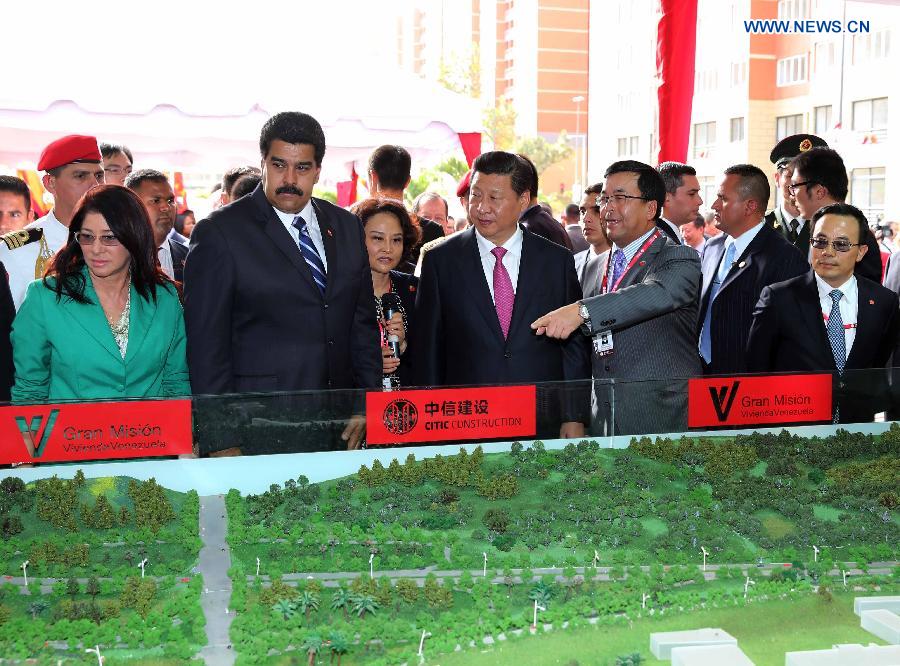China and Latin America's 'shared destiny'
- By John Ross
 0 Comment(s)
0 Comment(s) Print
Print E-mail China.org.cn, July 24, 2014
E-mail China.org.cn, July 24, 2014
|
|
|
Chinese President Xi Jinping (C), accompanied by his Venezuelan counterpart Nicolas Maduro (2nd L), visits a housing project in Caracas, capital of Venezuela, July 21, 2014. This housing project which is co-worked by China and Venezuela, aims to help 3 million Venezuelan families by 2019, [Xinhua/Lan Hongguang] |
China has already promoted infrastructure projects as a key way of ensuring Asia's economic integration. Similarly Latin America's economic integration cannot be achieved without large scale infrastructure links. China's huge financial resources – the world's largest foreign exchange reserves and an economy generating over US$4 trillion a year for capital investment compared to only US$2 trillion in the United States – makes it the world's strongest economy to aid and participate in such development. China's infrastructure capabilities also reach far beyond finance – its sale of ultra-high voltage transmission lines to Brazil, for example, is already important in aiding developing the hydro-electric power potential of the Amazon. Discussions between Brazil, Peru and China, during Xi Jinping's visit, on the development of a transcontinental railway indicate the scope of what is possible. On a smaller scale China is lending US$2.1bn to Argentina for railway development, and US$4.7bn for dam and power construction.
This interlinks with the considerable importance for Latin America of the announcement, at their recent summit, by Brazil, Russia, India, China and South Africa (BRICS) of the establishment of the US$50bn BRICS development bank and the US$100bn BRICS contingency fund. In terms of international finance, previously U.S. dominance of the IMF resulted in that organization not being used as a way to allow developing economies to expand their economies, and overcome short term economic problems, but instead to impose policies which typically served U.S. interests and blocked economic growth of countries receiving loans. Latin American countries, as well as those in Asia, experienced this. Despite U.S. government proposals to reform the IMF to better reflect the weight of developing economies, made during the international financial crisis, the U.S. Congress has not passed the necessary legislation to achieve this. The BRICS countries were able to agree to establish a lending mechanism which helps circumvents the U.S. veto in the IMF.
China's loan and aid policy, which is therefore likely to be influential in the new BRICS institutions, has radically differed from the IMF. China has not required from those receiving loans or aid domestic economic policy conditions – China merely, and self-evidently, required that its loans had to be repaid, receiving in a number of cases guarantees not only in cash but in commodities. But China did not specify what domestic policies should be pursued to ensure loan repayment but left this to the country concerned – an entirely different approach to the IMF.
The BRICS development bank and contingency fund is therefore potentially important not only for long term growth but for allowing Latin America to avoid experiences of the type seen in the continent's "lost decade" of the 1980s, when severely contractionary economic policies were imposed on the continent as part of the "Washington Consensus." In addition to the long term development from the BRICS bank, the sums available from the contingency fund will help countries avoid being blackmailed into adopting unsuitable or damaging economic policies due to purely short term financial difficulties.
If the advantages of this for Latin America are evident, what are the advantages for China – because to be stable any relationship has to be win-win? The answer is not only in reciprocal trade and investment but the security in supply and markets Latin America can help bring to China.
China is sufficiently strong militarily that not even the most extreme U.S. neo-cons advocate a war with it. But China is dependent on extremely internationalized sources of supply and markets – it has already overtaken the United States as the world's largest goods trading nation. Therefore, if any country, for example the United States, wished to weaken China, it can attempt this by cutting off sources of supply or access to markets. For example, the sanctions implemented by the United States against countries such as Iran can directly put pressure on China's economy.
China naturally has to maintain stable economic relations with all Latin America countries, regardless of their political orientation. China was able to develop relations with Latin American countries even during earlier periods of right wing domination of the continent's politics. But such right wing regimes were generally closely linked to the United States and therefore cannot be relied upon to resist U.S. pressure for economic actions harming China. The present governments of Latin America, which generally have friendly relations with China, therefore provide a more stable basis for ensuring the security of China's trade relations. In turn, strong economic relations with China aid the policies of Latin America's governments.
It is for this reason that the political and economic aspects of Latin America-China interactions are interconnected. It also explains why they have developed into one of the world's most important relations.
The author is a columnist with China.org.cn. For more information please visit: http://www.china.org.cn/opinion/johnross.htm
Opinion articles reflect the views of their authors, not necessarily those of China.org.cn.







Go to Forum >>0 Comment(s)